Book of Opening the Mouth
Purification Ceremonies
THE FIRST CEREMONY.
To cleanse and purify the statue so that it might become a suitable and permanent dwelling-place for the KA was the object of the first ceremony. The SEM priest took up a vessel filled with clean water,in which salt or soda had been dissolved, and poured it into a bowl which was held in the hands of an assistant. He next walked round the statue four times, sprinkling the salted water on it on all sides, or perhaps washing portions of it, and meanwhile the Kher heb said four times:--
p. 43
"O Osiris, everything which is hateful in Unas hath been carried away for thee; for that which was uttered in his name of evil hath Thoth come, and he hath carried it away to Osiris. I have brought that which was spoken in the name of Unas of evil, and have placed it in the palm of thy hand. The SA shall not be separated from thee, and thou shalt not be separated from it."
From the way in which Osiris is mentioned in this passage it is clear that the cult of this god was general in Egypt when this Liturgy was drawn up, and that be was already recognized as the god of the dead. The effect of the sprinkling of water over the statue, or the washing of it with water, was to remove the sins of the deceased from him, and to cleanse his body and Ka. There can be no doubt that the Egyptians in all periods attached very great importance to the use of water ceremonially, and there is good reason for believing that they regarded it as one of the principal sources of life since the gods were created from water, and Nu, the great god of the celestial deeps, was the father of the gods. They believed that water possessed a mysterious power which made itself manifest under the form of life, and it may be noted in passing that, in the scenes in which Thoth and Horus are pouring out water over the heads of kings, the water is indicated by series of ankh signs
 , i.e., "life, life, life." Dümichen has already in this connection pointed out the fact that in the "Tale of the Two Brothers," Anpu put the heart of
, i.e., "life, life, life." Dümichen has already in this connection pointed out the fact that in the "Tale of the Two Brothers," Anpu put the heart ofp. 44
his younger brother Bata into a vessel of water; when the heart had absorbed all the water it came to life. Water not only washed away sin, but gave new birth and life to the dead.
The Gnostics, who preserved many ancient Egyptian beliefs, attached great importance to the use of water ceremonially, and, according to Irenaeus (Haeres, 1, 2, § 5), they threw oil and water over the heads of the dying to make them invisible to the powers of darkness. The ancient Egyptians certainly dissolved salt, or soda in some form, in their "holy water," and it is probable that they pronounced some formula over it before sprinkling it upon the dead. The sprinkling of the dead was the first and most important of burial ceremonies among the Egyptians for thousands of years, and it is probable that it was adopted, under the name of baptism of the dead, by many sections of the Christian Church. For centuries certain Christians actually baptized the dead, and they continued to do so in spite of the prohibitions of many Councils.
The exact meaning which is to be attached to the word tu or "evil" is not quite clear; 1 it was certainly connected with the words of Unas, but whatever it was this "evil" was carried to Osiris by Thoth. Here we see Thoth acting as a sort of advocate for Unas with Osiris, and playing his part as the "lord of divine words," and author of holy books, with which we are familiar from the texts of the Theban Recension of the
p. 45
[paragraph continues] Book of the Dead. In the Judgment it was he who "weighed words," and who weighed the heart of the dead man in the Great Balance, and reported the result to Osiris. It is the "words" of Unas which are in question here, and in Egypt both gods and men judged a man by his "words." The sprinkling of the water caused Thoth to carry the words of evil uttered by Unas, and place them in the hand of the god.
The words which were said by the Kher heb here, as in many other places in the Liturgy, were to be repeated four times. The Egyptians divided the earth into four quarters, over each of which a god presided, and in order to secure for the dead permission to move about freely through these quarters of the world, formulae, whether of blessing or of banning, were repeated four times, once for each god, and certain offerings were made in quadruplicate. The gods of the four quarters of the world at the time when this Liturgy was drawn up were Horus, Set, Thoth, and Sep, and they were probably the gods of the four cardinal points also. Later, however, their places seem to have been taken by the four sons of Horus, Mestha, Hapi, Tuamutef and Qebhsennuf, each of whom presided over one of the four pillars that held up the sky. The priest by walking round the mummy or the statue four times, and sprinkling water as he went, bestowed upon the Ka the power to journey into all parts of heaven and earth, and made him a pure being in respect of the four gods of the four quarters of the earth.
p. 46
At the end of the first formula quoted above come the words, "The Sa shall not be separated from thee, and thou shalt not be separated from it." By the word Sa, the Egyptians understood that mysterious energy and life-giving power which existed in the gods, and which for want of a better name we may call the "fluid of life." Its source was the Sun-god, by whatever name he is called, Horus or Ra, and Ra, in the text of Unas 1 is said to be "Sovereign of the divine Sa". The gods and goddesses received this Sa from Ra and communicated it to those whom they loved upon earth. According to M. Moret. 2 the fluid of life could be transmitted from the being who possessed it to the person to whom it was desired to transfer it, by embracing that person and by making "magnetic passes" along the back. M. Maspero also describes the Sa as a sort of "magnetic fluid," or "aura," which could be transmitted to a person by laying hands on him, or by making passes over the nape of the neck or the spinal column. The phrase setep sa means something like to "make passes." The Sa was transmitted to a king from the statue of a god by placing the arms of the statue round him, and by laying one of its hands on the nape of his neck as he knelt before it. 3
p. 47
[paragraph continues] When the statue had exhausted the store of the power which was in it, it was able to obtain a fresh supply from the Other World. The object of making passes before the statue of the dead, or his mummy, was to give a place in the fore-front of the company of the KHU, or "Spirits," in the Other World. This is certain from a passage in the text of Pepi I., wherein it is said, "The passes by which he obtaineth the fluid of life having been made over him by [Ra] and Horus, he is at the head of the KHU"
THE SECOND CEREMONY.
The ceremony of the sprinkling of water having been completed, the second ceremony begins. The SEM priest, or one of his assistants, took in his hand a censer in which incense has been placed, and having set fire in it, and made the incense to burn, he walked with it four times round the statue or mummy, and censed it, whilst the Kher heb recited the following four times:--"Let him that advanceth advance with his KA.
"Horus advanceth with his KA.
"Set advanceth with his KA.
"Thoth advanceth with his KA.
"Sep advanceth with his KA.
"Osiris advanceth with his KA.
"Khenti-maati 1 advanceth with his KA.
p. 48
"Thy Tet shall advance with thy KA.
"Hail, Unas! The arm of thy KA is before thee.
"Hail, Unas! The arm of thy KA is behind thee.
"Hail, Unas! The leg of thy KA is before thee.
"Hail, Unas! The leg of thy KA is behind thee.
"O Osiris Unas! I have given unto thee the Eye
of Horus, and thy face is filled therewith, and the perfume of the Eye of Horus is to thee."
This formula begins with an address to the statue, or mummy, which is bidden to advance, just as do Horus, Set, Thoth, Sep, Osiris, and Khenti-maati, i.e., the dweller without eyes (the Horus of the dark night when neither sun nor moon is visible), These gods are
p. 49
not separated from their KAU, and the KA of Unas, as the equal of their KAU, shall be with him. With his KA, however, shall come his Tchet, or Tet,
 , or
, or  , i.e., his backbone, or pillar which supports the backbone. The
, i.e., his backbone, or pillar which supports the backbone. The  , as Prof. Maspero has shown, represents the tree-trunk which was worshipped at Mendes in connection with Osiris; it was animated by Osiris, and was all-powerful in supporting the dead because of the presence of the god in it. Under the Middle and New Empires the
, as Prof. Maspero has shown, represents the tree-trunk which was worshipped at Mendes in connection with Osiris; it was animated by Osiris, and was all-powerful in supporting the dead because of the presence of the god in it. Under the Middle and New Empires the  is often seen painted on the bottoms of the insides of coffins, and when coffins were intended to stand on their feet, the
is often seen painted on the bottoms of the insides of coffins, and when coffins were intended to stand on their feet, the  was generally painted on the back outside. Thus when lying down the mummy rested on his
was generally painted on the back outside. Thus when lying down the mummy rested on his  and when standing up was supported by it. The KA of the deceased comes with him because it is supported by Osiris, and it comes with one leg and one arm before him, and one leg and one arm behind him. The exact signification of these expressions is unknown, but about the translation of the words there is no doubt.
and when standing up was supported by it. The KA of the deceased comes with him because it is supported by Osiris, and it comes with one leg and one arm before him, and one leg and one arm behind him. The exact signification of these expressions is unknown, but about the translation of the words there is no doubt.We next see that the incense with which the mummy is censed represents the Eye of Horus, or the Sun, and the use of the expression dates from the time when Horus was the greatest of the gods of heaven, and the sun was regarded as his eye. The sun was, of course, the source of heat and light, and therefore of all
p. 50
life, and "Eye of Horus" was a synonym for everything which was beneficial for the living and the dead. The hot fumes of the incense surrounded the mummy or statue and gave warmth to it, the smoke rose up before its face, which it covered with a sort of layer, and the general effect of the ceremony was to make the deceased pure and warm. The first ceremony removed sin from the new dwelling-place of the KA, and the second continued its purification, and gave to it the quickening beat which was derived from the Eye of Horus. The pungent smell of the incense formed a sort of atmosphere for the dead, and was pleasant to them.
THE THIRD CEREMONY.
The third ceremony of purification was performed by means of water, in which two different kinds of incense had been dissolved. The rubric in the text of Unas mentions "two balls" of incense, but that of the text of Peta-Amen-apt says that one ball shall be of incense of Shet pet, i.e., of the incense prepared from the salt found in the Natron Valley, and the other of the salt which is found near the city of Nekheb, or Eileithyiapolis. Shut pet was a portion of the Sekhet-Hemam, or "Field of Salt," known to-day as the "Wadi an-Natrun," which lies about forty-five miles to the northwest of Cairo, and the incense made from the salt deposits here was called "Incense of the North." The incense made from the salt deposits near Nekheb wasp. 51
called "Incense of the South." The KA whose statue had been purified by incense from each place was free to journey through the North and South of Egypt, and in a sense it made him "lord of the Two Lands," i.e., of all Egypt. The priest, having dissolved the balls of natron in the water in the vessel, poured it out into
a bowl held by an assistant. He then took the bowl, and, going round the statue four times, sprinkled it with the water of the natrons of the South and North, whilst the Kher heb repeated the following words four times:--
"This libation is for thee, O Osiris, this libation is
p. 52
"for thee, O Unas; it cometh forth from thy son, it cometh forth from Horus.
"I have come and I have brought unto thee the Eye of Horus, that thy heart may be refreshed therewith. I have brought it [and placed it] under thee, [under] thy sandals, and I have presented unto thee that which floweth forth from thee. Whilst it is with thee there shall be no stoppage of thy heart, and it shall be with thee with the things (or, persons) which came forth at the [sound of the] voice."
The libation now poured forth represents the moisture which Horus sends forth from himself and from his Eye, and is intended to take the place in the body of the deceased of that which flowed forth from him before death, or during the process of mummification. The deceased is identified with Osiris, and Horus therefore becomes his son. This fluid of Horus will make the heart of the deceased to live again, just as the water in which the heart of Bata was placed in the Tale of the Two Brothers, having been absorbed, made it to live. So long as a supply of it exists in the body of the deceased his heart shall not stop, and this supply was provided among the "things which come forth at the voice," i.e., the offerings. We have already seen that pert kheru is a name given to offerings, because they were believed to appear when the deceased, or the priest, ordered them to appear, and it is clear that the words pertha nek kheru in the text here refer to the offerings. The Egyptians attached great importance to
p. 53
spoken words, and they regarded the power of speech and the gift of the voice as mighty weapons, both for the living and the dead. The KAU, or Doubles, of the dead who had learned to utter words correctly, and who knew the proper tones to employ in uttering them, were in a position to go where they pleased and to do what they liked, for no god, spirit, fiend, or devil, and no inanimate object, could help obeying the commands which they uttered. The order for food or water having been given by them, food or water appeared forthwith.
In the passage translated above are the words "that which floweth forth," which I have used as the equivalent of the Egyptian word ertu. The exact meaning of the word is "effluxes," or "outflowings," and the determinatives show that by ertu we are to understand the strong-smelling liquid which exudes from a dead body. Several passages in the Book of the Dead support this view, as the following examples will prove. In Chapter LXIIIB. 2, we have, "I have lifted up the efflux from Osiris;" in Chapter CXIX., "Pure are the effluxes which are borne away from thee;" in Chapter CXLVII. 6, "I have come unto thee, Osiris, pure one of effluxes;"
p. 54
in Chapter CXLIX. (Aat XIII.), "Like the stream from the effluxes coming forth from Osiris;"
and in Aat XIV. of the same Chapter, "I shall not be destroyed by the effluxes which come forth from Osiris." The effluxes of Osiris here referred to are undoubtedly the humours which were believed to have drained out of the body of Osiris when Horus and his "sons" were embalming it. From the above passages it is clear that the Egyptians regarded these humours as pure or holy, for they represented the very essence of the god. Now the Egyptians were not the only people in the world who attached mystic power and importance to the fluid which ran out from the dead, but though the texts make it certain that they did, we cannot learn from them exactly why they should do so. The reason is, however, not far to seek. Mr. Crawley tells us (Mystic Rose, p. 287) that communion with the dead is most exactly reached, and the identity of eating with a person and eating him most clearly shown, in the common Australian practice in which mourners drink the humours of the decaying corpse, or eat its flesh. The Kurnai anoint themselves with decomposed matter from the dead. It is done in the Kingsmills to "remember
p. 55
him." So in Timorlaut mourners smear themselves with the fluids of the corpse. The Aru islanders drink them "to effect union with the dead man." Some of the liquid is kept in order to injure enemies. The object of drinking the liquid is, clearly, to obtain the qualities of the dead man, his strength, and, perhaps, his vital power, and it is possible also that those who indulged in such practices did so with the idea of avoiding injury from the departed spirit. What the Egyptians did with the humours of the dead is unknown, but in the case of great and holy men, that which drained from their bodies was certainly turned to some good account by the living. The custom of draining the dead body of its moisture is common enough among modern peoples of Central Africa, as we may see from the account of a great Baluba chief's death quoted by Sir H. Johnston (Grenfell and the Congo, ii., p. 655). "When an important Luba chief expires, every one, great and small, must mourn in a subdued tone; the members of all the brotherhoods come before the house where the body lies to perform dances; the women violently strike their hatchet and hoe against each other. This deafening hubbub lasts a day. . . . During this time a young slave is obtained, his neck is broken by a heavy blow, and he is laid by the corpse for two days. He is the chiefs boy attendant. His wives, squatting near him, do not cease their lamentations. Some days pass in this way without other incidents, after which the stiffened limbs
p. 56
are forcibly bent, and the body placed in the wicker 'coffin. In the house two stages are raised, one above the other; on the upper one is placed the coffin, on the lower one a large earthen pot. The body decomposes; a noxious liquid infested with maggots escapes from it and falls into the receptacle; it is left there for several weeks." The Belgian missionary who describes the chief's burial does not tell us what was done with the "noxious liquid," but, as human flesh and bones form an important element in the "medicines" which are prescribed by medicine men in Central Africa, we are probably justified in assuming that the liquid was used in the same way.
THE FOURTH CEREMONY.
The first ceremony removed evil or sin from the body of the deceased, the second gave it warmth, and the third restored to it the humours which had been expressed from it. For the fourth ceremony the SEM priest dissolved five grains of incense made from the salt deposits near the city of Nekheb, i.e., "Incense of the South," in a libation vase of water, and, having poured it into a vessel, walked with it four times round the mummy or statue, and sprinkled it each time. The name given to this libation water is "Semman," and of the five grains of salt, or alum, which it contained, one was for Horus, one for Set, one for Thoth, one for Sep, and one for Osiris, thatp. 57
is, for the deceased himself. Whilst the SEM priest walked round the statue the Kher heb said the following words four times:--
"[Here is] Semman! [Here is] Semman!
"Open thy mouth, O Unas, and taste thou the taste thereof in the halls of the god, for Semman is the emission of Horus, for Semman is the emission of Set,
for Semman is the stablisher of the heart of the two Hawk-gods (i.e., Horus and Set). Thou art cleansed with hesmen (natron), and thou art like unto the followers of Horus."
The libation thus poured out either represented the essence of Horus and the essence of Set, which was the
p. 58
source of the strength of their hearts, and the substance which gave them life, or was believed to be transmuted into that essence through the words of power spoken by the Kher heb. The power of the Semman water was great, for as soon as it touched the face of the deceased his mouth was opened, and he was able to taste the emission, or life essence, of Horus and Set. Having tasted it, his whole being was changed, and he became a new creature, and henceforth he was a counterpart of the Shemsu Heru or "Followers of Horus." The Horus here referred to must not be confounded with the twin-brother of Set. The Horus who is always associated with Set is "Horus the Great," or "Horus the Elder," the Haroeris of the Greeks, but the Horus mentioned in the Liturgy in connection with "Followers" is "Horus, the son of Isis."
The "Followers of Horus" were a group of beings who were closely connected with Osiris, and having "followed" him in this world they passed after him into the Other World, where they became his ministrants and messengers, partaking of his immortal nature, and sharing his life. Horus the Elder was "followed" by a group of beings also, but these were of a totally different character, for they were called "Mesentiu," i.e., "workers in metal," or "blacksmiths." In some texts the followers of Horus, the son of Isis, are identified with the metal-workers of
p. 59
Horus the Elder, and it is possible that this is the case in the Liturgy. On the other hand, the deduction to be made from our text seems to be that the essence of Horus and Set introduced into the body of the deceased changed his nature into theirs, while the cleansing with natron made him a counterpart of the followers of Horus, the son of Isis. He thus possessed the nature of Horus, the oldest god of heaven, and the nature of a "follower" of the son of the man Osiris, who rose from the dead and became the ever-living god and judge of the dead.
THE FIFTH CEREMONY.
The next ceremony continued the process of assimilating the deceased with the gods. The priest, having dissolved five grains of incense made from the salt deposit in a place in the Natron Valley called Shet pet," "Lake of Heaven," in a libation vase of water, and poured it into a vessel, walked with it four times round the mummy and sprinkled it each time. As he did so the Kher heb said the following words four times:"Thou art purified with natron, and Horus is purified with natron.
"Thou art purified with natron, and Set is purified with natron.
"Thou art purified with natron, and Thoth is purified with natron.
p. 60
"Thou art purified with natron, and Sep is purified with natron.
"Thou art purified with natron, and thou art stablished among them.
"Thy mouth is the mouth of the sucking calf on the day of his birth."
It is possible to translate "Thou art purified with
natron as Horus is purified with natron," &c., as did Dümichen, but it seems better to render the passage without the addition of "as" in each member, for it is clear that the salted water was offered as much to the deceased as to each god. The effect of this sprinkling was to give the deceased power to take his place with
p. 61
the gods of each of the four quarters of heaven, and to make him their equal. In the last line of the passage, "Thy mouth is the mouth of the sucking-calf on the day of his birth," we appear to have an allusion to the calf figured in the Vignettes to Chapter CIX. of the Book of the Dead, which is entitled "The Chapter of knowing the Souls of the East." In the Theban Recension we see the deceased standing in adoration before Ra-Harmachis, between whom and the deceased is a spotted calf. In the Saïte Recension the deceased stands in adoration before the Boat of Ra, which is about to pass between the two "Trees of Emerald" into the sky. In the Boat are: 1. Ra-Harmachis, with the sign for wind above his disk. 2. The deceased. 3. A calf with a star above his back. The text tells us that the Souls of the East are Ra-Harmachis, the Calf of the goddess Khera (?), and Neter-tuai, or the planet Venus. The "Sucking-calf" must therefore be the name of a morning star which was associated with the rising sun, and with Isis as a morning star. It seems clear, then, that the passage in the Liturgy signifies that the deceased is identified in it with the star which was born in the sky at sunrise; as its mother was Isis the star was a form of Horus, son of Osiris and Isis, and the deceased is therefore the son of Osiris, that is, Horus.
THE SIXTH CEREMONY.
In the next ceremony the SEM priest continues the purification of the deceased, and on this occasion he takes in his hand a ball of incense and lifts it up before the face of the mummy, or statue. We may assume that he does this four, or even five, times, and offers four balls of incense, one for Horus, one for Set, one for[paragraph continues] Thoth, and one for Sep. Meanwhile the Kher heb says:--
"Thou art purified with natron, and Horus is purified with natron.
"Thou art purified with natron, and Set is purified with natron.
"Thou art purified with natron, and Thoth is purified with natron.
"Thou art purified with natron, and Sep is purified with natron.
p. 63
"Thou art purified with natron, and thy KA is purified with natron.
"Thou art purified with natron,
"Thou art purified with natron,
"Thou art purified with natron,
"Thou art purified with natron,
"O thou who art stablished among thy brethren the gods.
"Thy head hath been censed for thee, thy bones have been cleansed thoroughly for thee, and thou art filled with that which belongeth unto thee. O Osiris, I have given unto thee the Eye of Horus, and thy face is filled therewith, and it spreadeth its odour about thee."
THE SEVENTH CEREMONY.
DESCRIPTION OF THE OFFERINGS.
THE ceremonies of purification are now ended. The new body in which the KA is to dwell has been made by means of them. Its bones, and head, and mouth have been brought into a state of ceremonial purity, it contains the fluid of life, and all its humours, andwarmth, and its face is enveloped with an emanation from the Eye of Horus, and the odour of purity has been restored to it. It is not, however, prepared to enjoy the offerings which are about to be presented to it, because its jaw-bones, which have been pressed out
p. 65
of their places under the process of mummification, have no freedom of movement. To "establish" the jaw-bones was the next thing. The SEM priest took in his hands the instrument called "KEF PESESH," i.e., "the overcomer of the divisions," the shape of which was
 , and presented it before the face of the mummy, or touched it with it. Meanwhile the Kher heb said these words:--
, and presented it before the face of the mummy, or touched it with it. Meanwhile the Kher heb said these words:--"O Unas, thy two jawbones which were separated have been established."
As the result of these words the jawbones resumed their former positions, and power was given to them to masticate food. It is interesting to note that a specimen of this instrument is preserved in the British Museum (Third Egyptian Room, Table-case M, No. 888). It is made of flint, and was found near Abydos with large numbers of flint knives and tools of the Neolithic Period. If the object be a KEF PESESH, and there is no reason to doubt it, it forms an important proof which connects this ceremony with the Predynastic Period. Compare also another example of this amulet, which is surmounted by the head of a goddess, in the British Museum (Table-case F, Fourth Egyptian Room, No. 505).
THE EIGHTH CEREMONY.
The SEM priest next presented before the face of the mummy two objects of the shape , or
, or  made
madep. 66
of iron of the South and iron of the North respectively, and the Kher heb said twice:--
"O Unas, the two gods have opened for thee thy mouth."
The "two gods" are, of course, Horus and Set. It will be noted that in the text of Unas the two iron objects which represent Horus and Set are in the form of axe-heads attached to handles,
 and that in the
and that in thetext of Peta-Amen-apt they are in the form
 . Amulets in both forms are known, for, as Professor Maspero has pointed out, small axes, with heads of metal and handles of wood, have been found in the tombs. and also small angles of haematite, of which many examples exist in our museums. 1 The application of these objects to the mouth of the mummy was, no
. Amulets in both forms are known, for, as Professor Maspero has pointed out, small axes, with heads of metal and handles of wood, have been found in the tombs. and also small angles of haematite, of which many examples exist in our museums. 1 The application of these objects to the mouth of the mummy was, nop. 67
doubt, intended to supplement the presentation of the KEF PESESH.
THE NINTH CEREMONY.
The first object presented to the mummy after the opening of the mouth was sel, or ser, which has been translated both by "butter" and "cheese." The Vignette represents the SEM priest offering a vessel with four balls, or round cakes, of some substance in it,
which has been translated both by "butter" and "cheese." The Vignette represents the SEM priest offering a vessel with four balls, or round cakes, of some substance in it,and, when we remember that the Egyptians have never made butter in our sense of the word, we are justified in accepting Dümichen's rendering of "cheese." 1 Whilst the four cakes of cheese were being offered, the Kher heb said the following words:--
"O Unas, the Eye of Horus hath been presented
p. 68
unto thee, and with it the god passeth (or, cometh); I have brought it unto thee: place thou it in thy mouth"
THE TENTH CEREMONY.
The SEM priest next brought in a vessel four balls, or round cakes, called shaku, and whilst he presented these the Kher heb said:--O Unas, the SHAKU Of Osiris have been presented unto thee, the SHAKU from the top of the breast of Horus, of his body hast thou taken to thy mouth."
The exact meaning of the word shaku is unknown, but it seems clear that the object symbolized the nipples on the breast of Horus, or the nipples on the breast of his mother Isis, which the god had taken into his mouth.
THE ELEVENTH CEREMONY.
In the next ceremony the SEM priest offered a vessel of milk and a vessel of whey (?), and whilst he did so the Kher heb said:--"[That which is] from the breast of thy sister Isis, the emission of thy mother, thou hast taken possession of for thy mouth."
The text of Peta-Amen-apt is somewhat fuller, and reads:--
"[That which floweth] from the breast of Horus, and is of his body, hath been presented unto thee for thy mouth. That which cometh from the breast of thy sister Isis, the emission of thy mother, hath been seized by thee for thy mouth, and thou openest thy mouth by means of it."
THE TWELFTH CEREMONY.
The ceremonies symbolizing the nursing of Horus by Osiris having been performed, the SEM priest took libation vases of pure water of the north, i.e., from the Delta, not water with natron dissolved in it, and wentround the mummy, sprinkling it on all sides as he went, whilst the Kher heb said four times:--
"This libation is for thee, O Osiris, this libation is for thee, O Unas; it cometh forth from thy son, it cometh forth from Horus.
"I have come and I have brought unto thee the Eye of Horus, that thy heart may be refreshed therewith.
p. 71
"I have brought it [and placed it] under thee, [under] thy sandals, and I have presented unto thee that which floweth forth from thee. Whilst it is with thee there shall be no stoppage of thy heart, and it shall be with thee, with the things (or, persons) which come forth at the [sound of] the voice."
The powers which the deceased enjoyed upon earth having now been bestowed upon him once more, or upon his KA, he is in the position of being able to
partake of the symbolic offerings which are about to be made to him, and to assimilate them after they have been transformed into spiritual meat and drink by the words of the Kher heb.
THE THIRTEENTH CEREMONY.
The SEM priest took in his hands two vessels, one filled with white and the other with black wine,p. 72
each holding one hathes measure, and as he presented them to the deceased, the Kher heb said:--
"Thou hast taken possession of that which hath flowed forth from the Eyes of Horus, and when they (i.e., the wines) are in front of thee they illumine thy face."
The white and the black wine were not intended to be drunk, but to be poured over the head and forehead of the deceased, so that the strength in them might be transmitted to his face. The wines, being regarded as emanations from the Eyes of Horus, the White and the Black, contained the divine power which existed in the Eyes of the god, and they transferred to the deceased the might of the Day and the Night.
THE FOURTEENTH CEREMONY.
In the next ceremony the SEM priest offered a bread-cake, of the kind called Hem, which was presented for the "lifting up of the face" of the deceased. This name is followed by the word tchaut, the exact meaning of which is not easy to say. In the "Hem"-cake Dümichen 1 thought he saw the original of a cake in use among the Egyptians which was stamped with a figure of a vanquished hippopotamus; this beast was the symbol of Set, or Typhon, as we know from the texts, and from Plutarch, 2 who says that he was chained. In the pictures of the chained hippopotamus 3 the head of the monster isp. 73
turned back," i.e., he is looking behind him, and it is possible that the name "Hem," which means "to turn back," was given to cakes because they were stamped with a figure of the animal in this attitude. The words pat tchaut Maspero renders by "Gâteau de passage," and Dümichen by "Hem-Brod wohlschmeckendes (?) the former rendering gives the better sense. The "Gâteau de passage" is the equivalent of the round bread-cake which is common all over Egypt and the
Sudan at the present day, and it is the first thing with which the native provides himself when he is about to set out on a journey. Whilst the SEM offers the hem cake the Kher heb says:--
"Day hath made an offering unto thee in the sky.
"The South and the North have caused an offering to be made unto thee.
"Night hath made an offering unto thee.
p. 74
"The South and the North have made an offering unto thee.
"An offering is brought unto thee. An offering thou seest, of an offering thou hearest.
"There is an offering before thee, an offering behind thee, an offering with thee."
THE FIFTEENTH CEREMONY.
The offering of "bread for the journey" is followedby that of onions. The SEM priest presented five onions to the deceased whilst the Kher heb said:--
"Osiris Unas, the white teeth of Horus are presented unto thee that they may fill thy mouth."
THE SIXTEENTH CEREMONY.
The Vignette which illustrates the next ceremony shows us the SEM priest kneeling before a small tablep. 75
on which rests a bread-cake, which is called "the Uten-cake, for the lifting up of the face." Whilst this bread-cake is being offered, the Kher heb said, according to the text of Unas, four times:--
"SUTEN HETEP TA to the KA of Unas."
These words were followed by:--
"Osiris Unas, the Eye of Horus hath been presented unto thee--the bread which thou eatest."
According to the text of Peta-Amen-apt the Uten-cake is to be divided into two equal parts, and the words "Suten hetep ta, to the KA of Peta-Amen-apt" are to be said four times in connection with each half. Whilst the SMEN priest offers these the Kher heb says four times:--
"Osiris, the Eye of Horus hath been presented unto thee--the bread which thou eatest, and thy mouth hath been opened thereby."
It has been said above (p. 21) that, though the words
p. 76
suten hetep ta may at one time have been intended to mean "May the king give an offering," it is clear they had already lost this meaning when the funerary texts were inscribed on the mastabas at Sakkarah. The passage from the text of Unas is an important proof that such is the case, for it is quite clear that the king is not entreated to give to Unas an offering. Here the words suten hetep ta occur some forty lines from the beginning of the Liturgy, where, in the ordinary course of things, we should expect them to appear. From the fact that they are ordered to be recited four times in one text, and eight times in the other, we are fully justified in believing that they are the opening words of a formula which was composed in primitive times and recited by priests and relatives on behalf of the dead, and that they were used by pious folk, as Dümichen first pointed out, in much the same way as "Paternoster" and "Ave Maria" are used in our own times. It may be noted too in passing that the passage from the Liturgy under consideration presents us with one of the oldest examples of the use of the formula "suten hetep ta en ka en," "May there be a royal offering to the KA of," which is so common on stelae from the XIIth Dynasty downwards.
THE SEVENTEENTH AND EIGHTEENTH CEREMONIES.
In the next two ceremonies the SEM priest offers two vessels of wine to the deceased, each containing a Hathes measure; one vessel is made of some whitep. 77
material, and the other of black. Whilst the former is being offered the Kher heb says:--
"Osiris Unas, the Eye of Horus hath been presented unto thee; it hath been snatched from the hand of Set, and thou hast taken possession of it for thy mouth, and thou hast opened thy mouth therewith."
And whilst the latter is being offered he says:--
"Osiris Unas, thy mouth is opened by that which
floweth(?) from thee." The words "Eye of Horus which hath been snatched from the hand of Set" refer to the belief that it was Set, the god of darkness, who swallowed the sun and moon during eclipses, and devoured the moon piecemeal after it was fourteen days old. The Eye of Horus was restored to him sometimes by Shu, who snatched it out of the hand of Set, 1 but more
p. 78
frequently by Thoth, who is often represented in the form of an ibis-headed man carrying the Eye of Horus
 before him in his hands. As the Eye of Horus was the abode of disembodied souls and spirits, the presentation of this eye to the mummy, or statue, was equivalent to restoring to it the soul of the deceased. In this passage, and throughout the Liturgy generally,
before him in his hands. As the Eye of Horus was the abode of disembodied souls and spirits, the presentation of this eye to the mummy, or statue, was equivalent to restoring to it the soul of the deceased. In this passage, and throughout the Liturgy generally,the fundamental idea of the presentation of objects which are symbolic of the Eye of Horus is to bring back to the deceased his KA and BA, i.e., soul and the various members of his spiritual and mental economy.
The wine in the black vessel is declared to be the fluids or humours which ran out of the deceased before death, or during the process of preparing him for the tomb. They are here restored to him in the form of wine, the nature of which is changed by the words of the Kher heb.
THE NINETEENTH CEREMONY.
The process of restoring to the deceased the fluid of his body is continued in the next ceremony, wherein the SEM priest presents to him a black stone vase, containing hent beer. Whilst he is doing this the Kher heb says:--"Osiris Unas, there hath been presented unto thee
that which hath been pressed out of thee, which hath come forth from thee."
THE TWENTIETH CEREMONY.
After the presentation of the wine and beer the SEM priest took in his hands a small table, or stand, on which were placed several bread-cakes of different shapes and kinds, called "Tchesert," i.e., "thep. 80
holy table." With this he advanced to the deceased, and whilst he offered it to him the Kher heb said:--
"O Ra, may the worship which thou hast in heaven and all the worship which is offered to thee be to Unas, and may everything which is offered to thy body be offered to the KA of Unas; and may everything which is offered to his body be thine."
From this passage we learn that the deceased is identified with Ra, and that it was expected that he would share with Ra the praises, and worship, and offerings which were dedicated to him. The offerings made to the deceased were intended for Ra, upon whom devolved the duty of feeding him with a portion of them. The bread-cakes of earth were transmuted into the "bread of everlastingness," and the wine into the "wine of eternity," whereon Ra lived.
THE TWENTY-FIRST CEREMONY.
In the next ceremonies the various kinds of bread and cakes on the "Tchesert" table were offered one by one. The first was the tept, and as the SEM priest presented it the Kher heb said:--"Unas, the Eye of Horus hath been presented unto thee for thy tasting."
Here there is a play on the words tept, a "kind of bread," and tep, "to taste."
THE TWENTY-SECOND CEREMONY.
The next offering was the ah which according to Dümichen was not a bread-cake, but a lump of cooked meal, like the Puls of the Romans and the Polenta of the modern Italians. According to Maspero, it was a flat cake mixed with fat, and perhaps sweetened, and folded like a pancake. Whilst the SEMp. 82
priest presents this the Kher heb pronounces a formula, which in the Unas text seems to mean,
"The darkness (or, the night) becometh denser and denser," and in the text of Peta-Amen-apt,
"The ah food is spread out before thee like a field."
It is clear that in the one text there is a play of words in ahah and akka, and in the other in ahah and ah, but the exact meanings of the sentences are unknown because we do not understand the allusions.
[paragraph continues] Dümichen thought that the word akka, i.e., "darkness or night," referred to the colour of the ah-cake, and that it might have been baked to a brown colour which was so dark in comparison with the tept cake that it appeared to be black.
THE TWENTY-THIRD CEREMONY.
In this ceremony the SEM priest offered the breast of some animal, and as he did so the Kher heb said:--p. 83
"Unas, the Eye of Horus hath been presented unto thee so that it may embrace thee (or, be united unto thee)."
The breast naturally symbolized the act of embracing, which was in itself an important ceremony. When Horus embraced the deceased, the act of embracing him "smote Set," and when he had snatched his Eye out of the hand of the god of evil, "he gave to the deceased his heart, and the power which was therein." 1
When, in the Tale of the Two Brothers, Anpu restored to Batau his heart, each embraced the other. 2 Life
p. 84
was given to a statue by embracing it, and when a living person, priest, or relative embraced a mummy, his, or her, object was to reunite the bones, to knit together afresh the flesh, and to give order to the members of the body, which in primitive times had been dislocated, like the body of Osiris, and then put together, piece by piece, to form a complete whole. 1 As to the breast itself, we may note in passing that in the Levitical law it was ordered that the breast of a ram should be waved for a wave offering before the Lord (Leviticus vii. 30).
THE TWENTY-FOURTH CEREMONY.
The next four ceremonies deal with the offering of wine and three kinds of beer. The SEM priest presentedp. 85
a white vessel of wine to the deceased, and as he did so the Kher heb said:--
"Unas, the Eye of Horus hath been presented unto thee, which was snatched from the hand of Set, and was rescued for thee, and thou dost open thy mouth with it."
THE TWENTY-FIFTH CEREMONY.
He next offered a black vessel containing a hent measure of beer, 1 while the Kher heb said.--"Unas, there hath been presented unto thee that which hath been pressed out and cometh forth from Osiris."
THE TWENTY-SIXTH CEREMONY.
This was followed by an offering of an iron vesselp. 86
containing one hent measure of beer, 1 and at the same time the Kher heb said:--
"Unas, the Eye of Horus hath been presented unto thee, which was rescued for thee; there is no iron therein, and it belongeth to thee."
In the "iron vessel" we may probably see an allusion to the iron spear with which Horus defended himself against the attack of Set. If this be so we are to understand from the text that the strength of the iron
weapon is transferred to the vessel, which in turn transfers it to the beer. From the beer the deceased obtains the magical power of Horus which will enable him to repulse any attack made upon him by Set.
THE TWENTY-SEVENTH CEREMONY.
The SEM priest then offered a hetemet vessel containingp. 87
one hent measure of beer, 1 and as he did so the Kher heb said:--
"Unas, the Eye of Horus hath been presented unto thee that thou mayest be filled therewith."
At this point in the service the SEM priest paused in his presentation of offerings to the deceased, and made ready to pour out further libations to him. Having dissolved three cakes of natron in pure water, he took four vases of the solution, and walked round the
mummy, or statue, and sprinkled it on all sides, whilst the Kher heb recited the following, words four times:--
"This libation is for thee, O Osiris, this libation is for thee; it cometh forth from thy son, it cometh forth from Horus.
"I have come and I have brought unto thee the Eye of Horus that thy heart may be refreshed thereby. I
p. 88
have brought it to thy feet, and have presented unto thee that which hath flowed and come forth from thee. Whilst it is with thee there shall be no stoppage of thy heart, and it shall be with thee, with the things (or, persons) which come forth at the [sound of] the voice."
THE TWENTY-EIGHTH TO THIRTY-FOURTH CEREMONIES.
These seven ceremonies deal with the anointing of the mummy, or statue, with seven kinds of unguents, which are called:--2. Hekenu,
3. Sefth,
4. Neshnem,
5. Tuatu,
6. Hatet ash,
7. Hatet Thehennu,
The SEM priest offered a vessel of the Seth heb unguent, and the Kher heb said four times:--
"Osiris Unas, I have filled thine eye for thee with metchet oil."
He, next offered a vessel of Hekenu. Unguent, and the Kher heb said:--
"Osiris Unas, there hath been presented unto thee
that which hath been pressed out from thy face."
He next offered a vessel of Seft unguent, and the Kher heb said:--
"Osiris Unas, the Eye of Horus hath been presented unto thee, and [Set] hath been made weak in respect of thee thereby."
The Seft unguent was dark in colour, and symbolized Set, the god of darkness, and as it represented the
p. 90
greasy emanation of his face this god was supposed to suffer through its absence.
The SEM priest next offered a vessel of Neshnem unguent, and the Kher heb said:--
"Osiris Unas, the Eye of Horus hath been presented unto thee, that it may unite itself unto thee."
He next offered a vessel of Tuatu. unguent, and the Kher heb said:--
"Osiris Unas, the Eye of Horus hath been presented unto thee, that the gods may be brought unto thee thereby."
In the text of Peta-Amen-apt the reading is:--
"[Osiris] Peta-Amen-apt, the Eye of Horus hath been presented unto thee. It hath been brought [unto thee] that thou mayest worship (or, give thanks to) the gods by means of it."
The SEM priest then offered a vessel of the finest cedar oil, Hatet ash, and a vessel of the finest oil of the Thehennu (Hatet Thehennu), and the Kher heb said:--
"O ye Oils, O ye Oils, which are on the forehead of Horus [place ye yourselves on the forehead of the Osiris Unas, make ye him to smell sweet in possessing you], make ye him to become a KHU (i.e., Spirit) through possessing you, make ye him to have his SEKHEM (i.e., Vital Power) in his body, make ye him to have openings before his eyes, and let all the KHU (i.e., Spirits) see him, and let them all hear his name. Behold, Osiris Unas, the Eye of Horus hath been
p. 91
brought unto thee, for it hath been seized that it may be before thee."
THE THIRTY-FIFTH CEREMONY.
In this ceremony the materials with which the eyes of the deceased are to be painted are offered. The SEM priest took a bag of Uatch and a bag of Mestemet, and as he offered them the Kher heb said:--"Osiris Unas, I have painted for thee the Eye of Horus with Mestemet so that there may be health to thy face."
The eye-paint called Uatch was first used as a medicine for the eyes, and only later as an ornament; it was a preparation of copper. The eye-lids were first smeared with oil or some unguent, and the powder was
p. 92
applied to them by means of a short, thin stick made of wood, bone, or metal, which among the Arabs is called a "needle." The eye-paint Mestemet, which appears in Coptic under the form
 , or
, or  , was made from antimony, and its use was general; it was used daily, and was believed to protect the eye against ophthalmia. In modern times preparations of lead, black oxide of manganese, the lamp-black of burnt almonds, &c., are commonly used as "Kohl," or eye-paint.
, was made from antimony, and its use was general; it was used daily, and was believed to protect the eye against ophthalmia. In modern times preparations of lead, black oxide of manganese, the lamp-black of burnt almonds, &c., are commonly used as "Kohl," or eye-paint.THE THIRTY-SIXTH CEREMONY.
In the next ceremony the SEM priest offered two linen bandlets, or scarves, or sashes, called unkhu to the deceased, and as he did so the Kher heb said-"Watch thou in peace. The goddess TAAT watcheth in peace, the goddess TAAT watcheth in peace. The Eye of Horus which is in the city of Pe-Tep watcheth in peace. The Eye of Horus which is in the temple houses of Net watcheth in peace. Receive thou the milk-[white] and bleached bandlets of the goddess Ur-a. Cause ye, O bandlets, that the Two Lands may submit to this Unas, even as they bow down before Horus, and make ye the Two Lands to be in awe of Unas, even as they are terrified before Set. Tarry ye before Unas in his divinity. Open ye his way at the head of the KHU (or, Spirits), and let him stand at the head of the Spirits. O Anpu-Khenti Amenti, forwards, forwards, to the Osiris Unas."
p. 93
The two bandlets are assumed to have been made by the goddess Taat, who presided over the apparel of the deceased, and provided them with raiment made by her own hands; as she wove the bandlets she wove into them her magical protection, which not only preserved their wearers from the discomforts of nakedness, but assured to them the respect of the gods and spirits who
saw them. One bandlet also carried with it the protection of the Horus-god who dwelt in the city of Pe-Tep, or Buto, and the other the protection of the Horus-god who dwelt in the city of Net (Neith). Horus of re-Tep was the son of Isis-Uatchit, and Horus of Sais was the son of Net, the goddess to whom
p. 94
the invention of the art of weaving was attributed. The city of Sais was famous in all ages for the production of textile fabrics, and here was situated "Hetmenkh," the "Temple of woven stuffs." 1 The opening lines of this passage in the Liturgy are differently translated by Dümichen and Maspero. In his translation of the text of Unas Maspero rendered the signs
 by "Vêts-toi," "clothe thyself," but later he came to the conclusion that
by "Vêts-toi," "clothe thyself," but later he came to the conclusion that  is not the equivalent of
is not the equivalent of  , and that it is to be read res, i.e., "Watch," or "Keep vigil." Thus his renderings are:--
, and that it is to be read res, i.e., "Watch," or "Keep vigil." Thus his renderings are:-- p. 95
for the following words he has "Nimin in Empfang die milchfarbige und die gebleichte von der Göttin Ur-a. Bewirket, dass sich in Ehrfurcht beugen die Länder," &c. 1
At this stage in the service an interval appears to have been allowed to the deceased to absorb the meat and drink offerings which had been presented to him, and to take possession of the bandlets, &c. In the temples the presentation of offerings to the god was nearly always accompanied by a burning of incense, 2 for the gods rejoiced in the mingled odours of the objects offered and the burning incense.
THE THIRTY-SEVENTH CEREMONY.
The SEM priest next burned incense, and as he was doing this the Kher heb said four times:--"Let him advance! Let him advance with his KA! Horus advanceth with his KA, Set advanceth with his KA, Thoth advanceth with his KA, Sep advanceth with his KA, Osiris advanceth with his KA, Khenti-Maati advanceth with his KA, thy backbone,
 advanceth with thy KA.
advanceth with thy KA."Hail, Unas! The arm of thy KA is before thee.
"Hail, Unas! The arm of thy KA is behind thee.
"Hail, Unas! The leg of thy KA is before thee.
"Hail, Unas! The leg of thy KA is behind thee.
p. 96
"Osiris Unas, I have given unto thee the Eye of Horus, and thy face is filled therewith, and the perfume of the Eye of Horus spreadeth itself over thee."
THE THIRTY-EIGHTH CEREMONY.
This censing of the mummy, or statue, was followed by another set of libations. Whilst the SEM priest was sprinkling the deceased with water in which two grains, or cakes, of incense had been dissolved, the Kher heb said four times:--"This libation is for thee, O Osiris, this libation is
p. 97
for thee, O Unas; it cometh forth from thy son, it cometh forth from Horus.
"I have come and I have brought unto thee the Eye of Horus, that thy heart may be refreshed therewith. I have brought it [and placed it] under thee, [under
thy sandals,] and I have presented unto thee that which floweth forth from thee. Whilst it is with thee there shall be no stoppage of thy heart, and it shall be to thee with the things (or, persons) which come forth at the [sound of] the voice."
CHAPTER IV.
THE LITURGY DESCRIBED.
WITH the pouring out of the last series of libations the first series of ceremonies at or in the tomb came to an end. In the text of Unas there is no break in the text to indicate this fact, but in the text of Peta-Amen-apt at this place come the following words:--"Here shall be set forth the food, and the drink, and the things which are to be placed on the altar, and one shall enter with the 'suten hetep' (i.e., 'royal "offering')."
This rubrical direction indicates that the ceremonies which have already been performed on the mummy, or statue, have opened the mouth of the deceased, and given him power to speak, and eat and drink, and that they have provided the KA with a pure statue wherein to dwell. The offerings up to this point were intended for the deceased only, and one of the chief objects in presenting them was to prepare the KA for partaking of the funeral feast which was to follow. The relatives of the deceased wished his KA to eat and
p. 99
drink with them, because it enabled them to establish and maintain communion with a being who had taken upon himself the nature of the gods. By eating the same food and drinking the same drink the souls of the living and the dead were joined in a bond which brought solace, consolation, and comfort to the living, and destroyed the feeling of separation from their beloved ones which death brought in its train. The funeral feast, that is, the eating of food together by the living and the KA, produced identity of substance, and as the KA was divine by virtue of the ceremonies which had been performed over him and the formulae recited during the presentation of offerings, his living kinsfolk became divine, and they became, for the time being at least, as gods. Since these ideas existed in connection with the funeral feast, there is small reason for wonder at the insistence in funerary texts on the necessity for a regular and constant supply of offerings in the tombs. It must also be remembered that the nature of the material offerings presented to the dead was changed during the act of offering by the sacred formulae which the Kher heb recited over them. The bread and meat, and wine and beer, were transmuted into the essence and substance of Horus, the great god of heaven. When these were eaten and drunk in a place ceremonially pure, which for the time being represented heaven, both the spirits of the dead and of the living ate and drank their god in the form of the spiritual natures of the material offerings, which the living
p. 100
absorbed into their material bodies, provided that such bodies were also ceremonially pure.
THE THIRTY-NINTH CEREMONY.
The second series of ceremonies began with the bringing in of the pert kheru, or offerings of meat and drink, which were to be placed upon the altar, and aministrant came with the suten hetep, or "royal offering." Whilst this was being done the Kher heb said:--
"Thoth returneth bringing it with him, he appeareth with the Eye of Horus."
"He hath given the Eye of Horus, and he is content therewith."
It has already been said that the Eyes of Horus, or the sun and moon, suffered eclipse at times through the
p. 101
agency of Set, and that the moon after the fourteenth day was devoured by him piecemeal each mouth. The souls of the dead who lived in the Eyes of Horus shared these calamities with the god, and thus it fell out that when the time had come to make the soul of the deceased to enter his body, the soul would be found to have disappeared with the solar or lunar Eye. Sometimes Horus went to look for his Eyes, and sometimes he sent one of them to look for the other; in every case the Eye was "found" and restored to the god. Occasionally Shu "found" the Eye in the hand of Set, and having rescued it from him he gave it back to Horus.
The god, however, to whom Horus was most often indebted for his Eye was Thoth, who presided over the stars, and knew the times of their appearances and disappearances, and regulated their courses. Thoth was called the "Heart of Ra," that is to say, he took possession of the soul of the god, and it was he who gave back the soul to the deceased, or to a god. 1 In the present case the mummy, or statue, of the deceased is ready to receive back his soul, and the Kher heb announces, as we have seen above, that Thoth hath returned with the Eye of Horus, which he had sought for, and that he hath given it to the deceased, who is content therewith. The deceased
p. 102
having once more regained his soul, is now able to enjoy the funeral feast.
THE FORTIETH CEREMONY.
The SEM priest next offered two suten hetep, cakes, or "royal offering cakes," and the Kher heb said:--"Osiris Unas, the Eye of Horus hath been presented unto thee, and he is content therewith."
THE FORTY-FIRST CEREMONY.
The offering of two vessels of beer in the usekh hall 1 followed, and the Kher heb said:--"Osiris Unas, the Eye of Horus hath been presented unto thee, and he is content therewith."
THE FORTY-SECOND CEREMONY.
The next line of the Liturgy is difficult to translate, for there are variants in the text. In the Vignette in the tomb of Peta-Amen-apt we see a man kneeling, with his left hand raised; it is clear that he is not making an offering, but it is probable that he is "seated" nearthe offerings, with the view of partaking of them. The meaning of the text seems to be something like:--
"He who sitteth down by the suten pert kheru (or royal offering) shall say: I have seated myself with it."
THE FORTY-THIRD CEREMONY.
In the next ceremony the priest presented for the ush(?) offering a Tua cake and a Shens cake, whilst the Kher heb said:--"Osiris Unas, the Eye of Horus hath been presented
p. 105
unto thee, and it hath been made to approach thy mouth for thee."
THE FORTY-FOURTH CEREMONY.
A Tut cake was next presented, and the Kher heb said:--"Osiris Unas, the Eye of Horus hath been presented unto thee for the smiting down of Set." 1
THE FORTY-FIFTH CEREMONY.
A Rethu cake was next offered, and the Kher heb said:--"Osiris Unas, the Eye of Horus, which was chained up [by Set], hath been presented unto thee."
The Rethu cake was round, and on it was probably
stamped a figure of a hippopotamus, symbol of Set, in fetters.
THE FORTY-SIXTH CEREMONY.
A vessel of Tchesert drink was next presented, and the Kher heb said:--"Osiris Unas, the Eye of Horus hath been presented unto thee, the little one, which became the food of Set (or, which entered into Set)."
The "little" Eye of Horus here referred to seems to be the moon, which, as already mentioned, was devoured piecemeal by Set after the fourteenth day each month.
p. 107
The passage in the Liturgy suggests that Set must, on one occasion, have found the new moon in the sky,
when he was roaming through the night, and swallowed it.
THE FORTY-SEVENTH CEREMONY.
A vessel of Khenemes beer was next offered, and the Kher heb said:--p. 108
"Osiris Unas, the Eye of Horus, which hath been smitten for thy mouth, hath been presented unto thee."
THE FORTY-EIGHTH CEREMONY.
In the next ceremony a bread-cake and a vessel of beer were placed on a small table, and "lifted up" before the mummy, whilst the Kher heb said:--"Osiris Unas, the Eye of Horus hath been presented unto thee, and it hath been lifted up for thee to thy face. There shall be lifting up to thy face, there shall be lifting up to thy face, O Osiris. Hail, Unas! let thy soul advance.
"Lift up thy face, O thou Unas, and look afar off, and fix thy gaze intently upon that which cometh forth from thee. That which was corruptible in thee
p. 109
hath been washed away, O Unas, and thy mouth hath been made holy for thee by the Eye of Horus."
THE FORTY-NINTH CEREMONY.
In the next ceremony there were presented as a Shebu offering a Tua cake and a Shens cake, and the Kher heb said:--"Let there be praise to thee and to thy KA, O Osiris,
which hath been cut away from the hand of him that doeth violence to the dead. O Unas, thou hast received these thy bread-cakes, which are from the Eye of Horus.
"Osiris Unas, the Eye of Horus hath been presented unto thee, [that is to say,] that which hath been mixed together for thee by it, so that thou mayest be filled with that which hath been pressed out and hath
p. 110
come forth from thee." This sentence was recited four times.
The presentation of the following offerings then took place; each object was offered to the mummy (or,
statue) four times, and each formula was recited by the Kher heb four times.
THE FIFTIETH CEREMONY.
The Sut joint, with the formula:--"Osiris Unas, the Sut joint hath been presented unto thee [as] the Eye of Horus."
THE FIFTY-FIRST CEREMONY.
Two vases of water, with the formula:--"Osiris Unas, the water which is in these hath been offered unto thee."
THE FIFTY-SECOND CEREMONY.
Two vessels of Bet incense, with the formula:"Osiris Unas, the Eye of Horus hath been presented unto thee that it may purify for thee thy mouth."
THE FIFTY-THIRD CEREMONY.
A Tua cake and a Shens cake as an Ush offering, with the formula:--"Osiris Unas, the Eye of Horus hath been presented unto thee, and it hath been offered unto thee for thy mouth."
THE FIFTY-FOURTH CEREMONY.
Two Tut cakes, with the formula:--"Osiris Unas, the Eye of Horus hath been presented unto thee, which struck down Set."
THE FIFTY-FIFTH CEREMONY.
A Rethu cake, with the formula:--"Osiris Unas, the Eye of Horus, which was put under restraint by him (i.e., by Set), hath been presented unto thee."
The Sem priest presenting a Rethu cake
THE FIFTY-SIXTH CEREMONY.
Two Heth cakes, with the formula:--"Osiris Unas, the Eye of Horus hath been presented unto thee, that thou mayest seize it for thy mouth."
THE FIFTY-SEVENTH CEREMONY.
Two Nehra cakes with the formula:--"Osiris Unas, the Eye of Horus hath been presented unto thee, and there hath been brought unto thee that which is intended for thy mouth."
THE FIFTY-EIGHTH CEREMONY.
Four Tept cakes, with the formula:--"Osiris Unas, [the Eye of Horus hath been presented unto thee], and hath been given unto thine Eye for thee to taste."
THE FIFTY-NINTH CEREMONY.
Four Peten cakes, with the formula:--"Osiris Unas, the Eye of Horus hath been presented unto thee, the glorious one; [these cakes] have been baked thereby."
THE SIXTIETH CEREMONY.
Four Shens cakes, (or Shens), with the formula:--"Osiris Unas, thou hast received thy head."
THE SIXTY-FIRST CEREMONY.
Four Amta cakes, with the formula:--"Osiris Unas, thine eye hath been presented that thou mayest take possession of it."
THE SIXTY-SECOND CEREMONY.
Four Khenfu cakes with the formula:--"Osiris Unas, the Eye of Horus, which hath been made in the form of fish-scales for thee, hath been presented unto thee."
The Sem priest presenting the Khenfu cakes
THE SIXTY-THIRD CEREMONY.
Four baskets of Hebennet cakes (?), with the formula:--"Osiris Unas, the Eye of Horus hath been presented unto thee, that it may well up with water(?) [before thee]."
THE SIXTY-FOURTH CEREMONY.
Four cakes made of fine, white flour (qemh), with the formula:--"Osiris Unas, the Eye of Horus, which was fettered by him [i.e., by Set], hath been presented unto thee."
THE SIXTY-FIFTH CEREMONY.
Four Atet cakes, with the formula:--"Osiris Unas, the Eye of Horus hath been captured and placed for thee in thy mouth."
THE SIXTY-SIXTH CEREMONY.
Four Pat cakes, with the formula:--"Osiris Unas, the Eye of Horus hath been presented unto thee; [it is] thy cake which thou eatest."
THE SIXTY-SEVENTH CEREMONY.
Four Ashert cakes, with the formula:--"Osiris Unas, the Eye of Horus, which was put under restraint by him [i.e., by Set], hath been presented unto thee."
THE SIXTY-EIGHTH CEREMONY.
Four onions, or bunches of onions, with the formula:--"Osiris Unas, his [i.e., Horus's] teeth, which are white and health-giving, have been brought unto thee."
The Sem priest presenting the onions
THE SIXTY-NINTH CEREMONY.
A haunch of beef, with the formula:--"Osiris Unas, accept (?) the haunch of beef [as] the "Eye of Horus."
THE SEVENTIETH CEREMONY.
A loin of beef (?), Aa, with a formula, two versions of which are extant. The rendering of one is:--"Osiris Unas, [here is] the marked piece of flesh and bone from which Seb cuts not off the aau joint," 1
p. 121
and of the other
[Osiris] Peta-Amen-apt, the mark of that which is "abominable (or, the abominable one) is burnt into the aa joint."
THE SEVENTY-FIRST CEREMONY.
A breast of an animal, with the formula:--"Osiris Unas, the Eye of Horus hath been presented unto thee, so that it may embrace thee."
THE SEVENTY-SECOND CEREMONY.
The Sut joint, with the formula:--"Osiris Unas, the Sut joint hath been presented unto thee as the Eye of Horus.'"
THE SEVENTY-THIRD CEREMONY.
Four ribs of beef (?), with the formula:--"Osiris Unas, the enemies have been presented unto thee [for they are thine, and thou hast smitten them]."
THE SEVENTY-FOURTH CEREMONY.
[Four] pieces of roasted flesh, with the formula:--"Osiris Unas, the things which are ordained for thee have been presented unto thee."
THE SEVENTY-FIFTH CEREMONY.
A liver, with the formula:--"Osiris Unas, the Eye of Horus hath been presented unto thee, so that thou mayest journey with it."
THE SEVENTY-SIXTH CEREMONY.
A spleen, with the formula:--"Osiris Unas, the Eye of Horus hath been presented unto thee, so that thou mayest go (?) with it."
THE SEVENTY-SEVENTH CEREMONY.
A fore-quarter of an animal, with the formula:--"Osiris Unas, the Eye of Horus hath been presented unto thee in the form of his fore-quarter [i.e., the fore-quarter, or shoulder, of Set]."
THE SEVENTY-EIGHTH CEREMONY.
Slices of meat from the fore-quarter, with the formula:--"Osiris Unas, accept(?) the Eye of Horus, which is in the form of the fore-quarter of Set."
THE SEVENTY-NINTH CEREMONY.
A Re goose, with the formula:--"Osiris Unas, the heads of the followers of Set have been presented unto thee [in the form of this] Sera goose."
THE EIGHTIETH CEREMONY.
A Therp goose, with the formula:--"Osiris Unas, this [goose] hath been presented unto thee according to thy heart's desire."
THE EIGHTY-FIRST CEREMONY.
A Set goose, with the formula:--"Osiris Unas, the Eye of Horus hath been presented unto thee, and it is carried unto thee."
THE EIGHTY-SECOND CEREMONY.
A Sert goose, with the formula:--"Osiris Unas, the Eye of Horus hath been presented unto thee [in the form of] the things which come for thee."
THE EIGHTY-THIRD CEREMONY.
A dove, with the formula:--"Osiris Unas, the Eye of Horus hath been presented unto thee, the glorious one, the dove which is thine."
THE EIGHTY-FOURTH CEREMONY.
A Saf cake, with the formula:--"Osiris Unas, the Eye of Horus, which was put under restraint by him [i.e., by Set], hath been presented unto thee."
THE EIGHTY-FIFTH CEREMONY.
Two Shat cakes, (or, honey-cakes), with the formula:--"Osiris Unas, the Eye of Horus hath been presented unto thee, and it shall not be cut off from him by thee(?)."
THE EIGHTY-SIXTH CEREMONY.
Two baskets of Nepat grain, with the formula:--"Osiris Unas, the Eye of Horus, which hath been counted 1 (or reckoned up), hath been presented unto thee."
THE EIGHTY-SEVENTH CEREMONY.
Two baskets of Mest grain, with the formula:--"Osiris Unas, the Eye of Horus hath been taken, and the water which is in it hath been made to be with thee."
The Sem priest presenting two baskets of Mest grain
THE EIGHTY-EIGHTH CEREMONY.
Two vessels of Tchesert drink, with the formula:--"Osiris Unas, the Eye of Horus hath been presented unto thee, the little one which became the food of Set."
THE EIGHTY-NINTH CEREMONY.
Two vessels of Tchesert drink, with the formula:--"Osiris Unas, the Eye of Horus hath been presented unto thee[, and there is power to it in thine hand]." 1
THE NINETIETH CEREMONY.
Two vessels of Khenemes drink, with the formula:--"Osiris Unas, the Eye of Horus hath been presented unto thee, and the fire of wrath rageth in him [i.e., Set] against thee."
THE NINETY-FIRST CEREMONY.
Two vessels of Heqt beer, with the formula:--"Osiris Unas, thou art filled with that which hath been pressed out and hath come forth from thee."
THE NINETY-SECOND CEREMONY.
Two vessels of Sekhpet grain, with the formula:--"Osiris Unas, thou art filled with that which hath been pressed out and bath come forth from thee."
THE NINETY-THIRD CEREMONY.
Two vessels of Pekh grain, with the formula:--"Osiris Unas, thou art filled with that which hath been pressed out and bath come forth from thee."
THE NINETY-FOURTH CEREMONY.
Two vessels of Nubian beer, with the formula:--"Osiris Unas, thou art filled with that which hath been pressed out and bath come forth from thee."
THE NINETY-FIFTH CEREMONY.
Two baskets of figs, with the formula:--"Osiris Unas, the breast of Horus hath been presented unto thee, and the gods eat of it together with thee."
THE NINETY-SIXTH CEREMONY.
Two vessels of wine of the North, with the formula:--"Osiris Unas, [there hath been presented unto thee that which filled thy father, and] 1 thy mouth hath been opened thereby."
THE NINETY-SEVENTH CEREMONY.
Two vessels of white wine, with the formula:--"Osiris Unas, the Eye of Horus, the glorious one,
p. 135
which he [i.e., Set] devoured and afterwards vomited, 1 hath been presented unto thee."
THE NINETY-EIGHTH CEREMONY.
Two vessels of Amt (?) wine, or wine of Pelusium, with the formula:--"Osiris Unas, the child which is in the Eye of Horus hath been presented unto thee, and thy mouth hath been opened thereby."
p. 136
By the words "child which is in the Eye," we are to understand "pupil of the eye," or "apple of the eye," i.e., that which is guarded as the most precious thing. The same idea exists in Hebrew, compare אִשׁו{! 0x5e ^ !}^ן, the "little man" of the eye (Deut. xxxii. 10; Proverbs vii. 2), and in Arabic
 . We have also "daughter of the eye," בַּת-עַיַן in Psalm xvii. 8, in Arabic
. We have also "daughter of the eye," בַּת-עַיַן in Psalm xvii. 8, in Arabic  , and in Ethiopic
, and in Ethiopic  = Greek κόρη (Deut. xxxii, 10 Psalm xvi. 9; Proverbs vii. 2).
= Greek κόρη (Deut. xxxii, 10 Psalm xvi. 9; Proverbs vii. 2).THE NINETY-NINTH CEREMONY.
Two vessels of Qem wine, or wine of Mareotis, with the formula:--"Osiris Unas, the Eye of Horus which was snared in a net hath been presented unto thee, and thy mouth hath been opened thereby."
THE ONE HUNDREDTH CEREMONY.
Two vessels of Senu wine, or wine of Syene, or Aswan, and the formula:--"Osiris Unas, the Eye of Horus, which hath no like, hath been presented unto thee, and it is to thee."
THE ONE HUNDRED AND FIRST CEREMONY.
Two vessels of Hebnent wine, with the formula:--"Osiris Unas, the Eye of Horus hath been presented unto thee, and it hath overthrown them [i.e., the companions of Set]."
THE ONE HUNDRED AND SECOND CEREMONY.
Two vessels, or baskets, of Khenfu cakes, with the formula:--"Osiris Unas, the Eye of Horus hath been presented unto thee, which hath been made in the form of these scale-shaped cakes for thee."
THE ONE HUNDRED AND THIRD CEREMONY.
Two vessels of Ashet fruit, with the formula:--"Osiris Unas, the Eye of Horus, which hath been snatched out of the hand of Set, hath been presented unto thee."
THE ONE HUNDRED AND FOURTH CEREMONY.
Two vessels of White Seshet grain, with the formula:--"Osiris Unas, the Eye of Horus hath been presented unto thee, the White One, the Glorious One, and it shall serve for thy food."
THE ONE HUNDRED AND FIFTH CEREMONY.
Two vessels of Green Seshet grain, with the formula:--"Osiris Unas, the Eye of Horus hath been presented unto thee, the Green One, the Glorious One, and it shall serve for thy food."
THE ONE HUNDRED AND SIXTH CEREMONY.
Two vessels of roasted Set grain, with the formula:--"Osiris Unas, the Eye of Horus, the Glorious One, which shall turn back [the fiends of Set], hath been presented unto thee."
THE ONE HUNDRED AND SEVENTH CEREMONY.
Two vessels of roasted Set grain, with the formula:--"Osiris Unas, the Eye of Horus hath been presented unto thee, the Glorious One, which shall turn back [the fiends of Set]."
THE ONE HUNDRED AND EIGHTH CEREMONY.
Two vessels of Babat fruit, with the formula:--"Osiris Unas, the Eye of Horus hath been presented unto thee, and behold, it is from Baba (?)."
p. 142
Dümichen thought that Baba was a name of Set, but it seems more probable that the Baba mentioned here is the first-born son of Osiris.
THE ONE HUNDRED AND NINTH CEREMONY.
Two vessels of Nebes fruit (mulberries?), with the formula:--"Osiris Unas, the Eye of Horus, which burneth with fire against them [i.e., the enemies of Set], hath been presented unto thee."
THE ONE HUNDRED AND TENTH CEREMONY.
Two vessels of Nebes cakes, with the formula:--"Osiris Unas, thine eyes have been made to open, and thou seest with them."
THE ONE HUNDRED AND ELEVENTH CEREMONY.
Two vessels of Hua grain, with the formula:--"Osiris Unas, the Eye of Horus hath been presented unto thee, the Glorious One, who was in his throat (?)."
THE ONE HUNDRED AND TWELFTH CEREMONY.
Two measures of sweet things of all kinds, with the formula:--"Osiris Unas, the Eye of Horus hath been presented unto thee, the sweetness of which followeth thee."
THE ONE HUNDRED AND THIRTEENTH CEREMONY.
Two baskets of spring fruit, flowers, and vegetables, with the formula --"Osiris Unas, the Eye of Horus hath been presented unto thee, and thou hast had experience thereof."
THE ONE HUNDRED AND FOURTEENTH CEREMONY.
Gifts of every kind, with the formula:--"Osiris Unas, behold, thou hast swallowed the things which were [intended] for thee."
The following section is taken from the text of Pepi II. Nefer-ka-Ra, and is not found in the ordinary copies of the Liturgy of Funerary Offerings:--
"1. May Seb give a royal offering to Pepi Nefer-ka-Ra!"
"2. I have given unto thee gifts of every kind, and
p. 146
set forth there bread and drink of every kind, which thou lovest and which are good for thee, before the god for ever and for ever."
"3. Osiris Pepi Nefer-ka-Ra, Horus hath come, and he hath made offerings to thee, because thou art his father,
Present Abt grain.
"4. and he maketh thee to return to Seb,
Present two vessels of Besen grain.
"5. and Seb giveth thee thy two eyes that thou mayest rest."
Present one altar.
"6. Osiris Pepi Nefer-ka-Ra, thou art his Double."
Present two Keha cakes.
"7. Accept the two eyes, O great one, Osiris Pepi Nefer-ka-Ra."
Present two Turt cakes.
"8. An offering, on behalf of them!"
Present two tables of offerings in the Usekht hall.
"9. Horus rests on thee, for thou art his father."
Present one bread offering.
"10. Accept the crop of the Eye of Horus, which I have gathered, and Horus hath given unto thee."
Present two vessels of Bat grain.
"11. Accept the crop of the Eye of Horus, which I have gleaned, and Horus hath given unto thee." Present two vessels of Bes grain.
p. 147
"12. Accept the Eye of Horus, which I have cultivated, and Horus hath given unto thee."
Present two vessels of Aha grain.
"13. Hath been presented unto thee that which hath been pressed out and come forth from Osiris."
Present two jugs of beer.
"14. Osiris Pepi Nefer-ka-Ra, accept the water which was in thee and Horus hath given unto thee."
Present two jugs of Thenem drink.
"15. Osiris Pepi Nefer-ka-Ra, I have presented unto thee the Eye of Horus, and have opened thy mouth with it."
Present two vessels of Wine of the North.
"16. Osiris Pepi Nefer-ka-Ra, accept the Eye of Horus which I have taken for him, which Horus hath given unto thee."
Present two vessels of Uatch Wine.
"17. Accept the Eye of Horus, which welleth up with water, and Horus hath given unto thee."
Present two vessels of Hebent drink.
"18. Accept the Eye of Horus, which I have seized for him and he hath given unto thee."
Present two vessels of Kheri-Khenfu drink (?).
"19. Accept the Eye of Horus, the White One, which I have bound up for him and he hath given unto thee."
Present two vessels of White Seshet grain.
p. 148
"20. Accept the Eye of Horus, the Green One, which I have bound up for him and he hath given unto thee."
Present two vessels of Green Seshet grain.
"21. Accept the Eye of Horus, which I have counted for Horus and he hath given unto thee."
Present two vessels of Nepat grain, or cakes.
22. Accept the Eye of Horus, which I have pursued for him and he hath given unto thee."
Present an Aat joint.
"23. Osiris Pepi Nefer-ka-Ra, the Eye of Horus hath been presented unto thee that thou mayest taste it."
Present two vessels of Teben grain, or fruit.
"24. Hail, Osiris Pepi Nefer-ka-Ra, the Eye of Horus hath been presented unto thee, it is sweet to the taste, and it followeth thee."
Present two vessels of fruit of all kinds.
"25. I count them for thee."
Present two vessels of spring fruit, flowers, and vegetables.
"26. Behold they have been swallowed by thee."
Present two tables of offerings.
27. Osiris Pepi Nefer-ka-Ra, this is the Eye of
"Horus, it germinateth in thee, in thee in thy name of 'Spearer of the Enemy.'"
Present offerings the whole year.
p. 149
28. Osiris Pepi Nefer-ka-Ra, Horus hath filled thee wholly with his Eye."
Present offerings at the Festival of Uak.
"Rejoice 1 and dance, O Pepi Nefer-ka-Ra, for standing up and sitting down thou hast thousands of vessels of beer, and joints of meat, and thy sheba offerings are from the house of the [divine] block. . . . As the god is filled with his divine offerings of bread, and cakes, and ale, so shall Pepi Nefer-ka-Ra be filled with his bread. Come to thy son, Osiris, the Spirit among the Spirits, the Sekhem in his places, whom the gods who are in the House of the Prince adore. Hail, Pepi Nefer-ka-Ra, I make thee to approach, and I lead thee to the tomb and to the funeral hall, that I may give unto thee the Eye of Horus, which I have counted for thee. Hail, thou hast swallowed that which was before thee. Hail, Pepi Nefer-ka-Ra, thou hast stood up and received the bread which is thine from my hand.
Recite four times.
"Hail, Osiris Pepi Nefer-ka-Ra, thou art at the door (?), thou restest [there] (?), O Pepi Nefer-ka-Ra, and remainest, O Pepi Nefer-ka-Ra, thou passest on. Thou utterest words to the regions of Horus, and thou passest on. Thou utterest words to the regions of Set, and thou passest on. Thou utterest words to the regions of Osiris, [and thou passest on]. A royal
p. 150
offering [to thee] in all thy forms. Thou puttest on thy loin-cloth, and thy panther skin, and thy girdle with a jackal's tail. Thou advancest with thy two vessels [for the blood], thou slaughterest the bull, thou advancest in the boat Uatch-An, in all thy forms, in all thy places. Thy mace is at the head of the living, and thy word is at the head of the Spirits. Anpu, president of the region of the West, and Antchet, who is at the head of the nomes of the East, make offerings unto thee of the things which are thine. Hail, Pepi Nefer-ka-Ra, thou art a counterpart of the gods thy brethren, . . . . thy son. Thou art endued wholly with the fluid of life in the earth. Attire thou thy body when thou comest into their presence."
Recite four times.



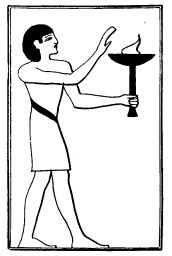
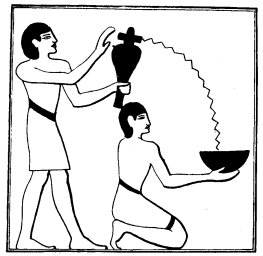
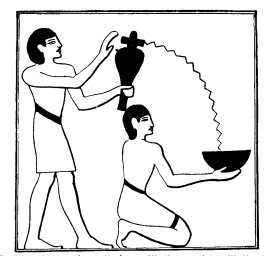
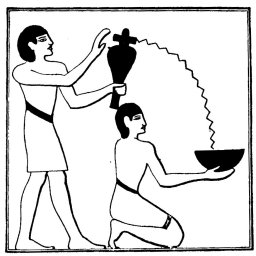
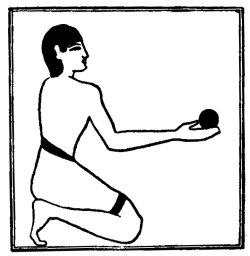
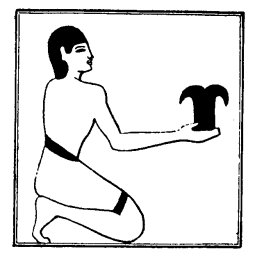
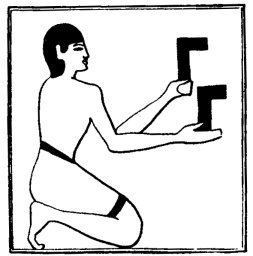
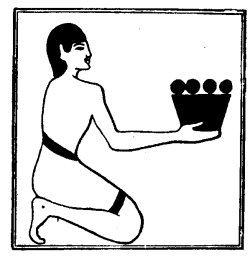
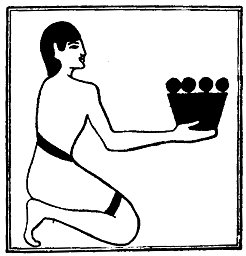
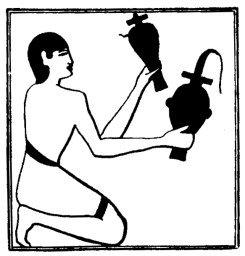
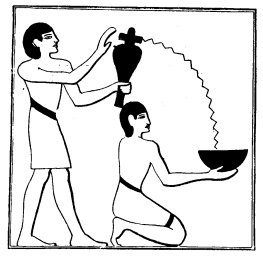
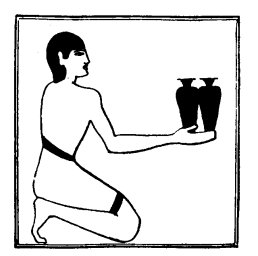
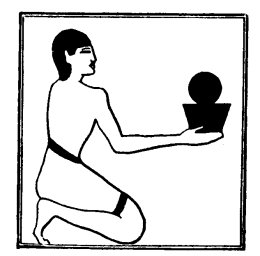
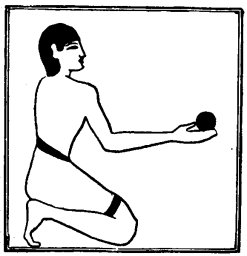
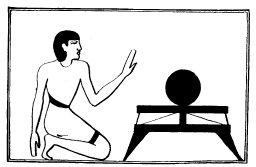
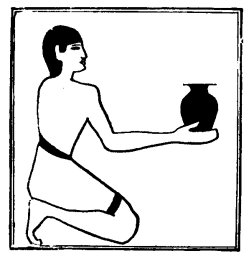
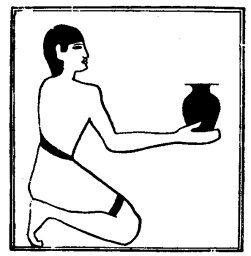
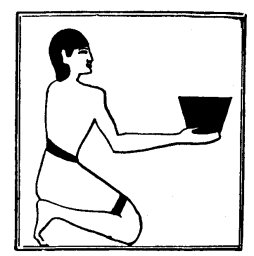
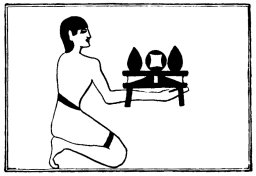

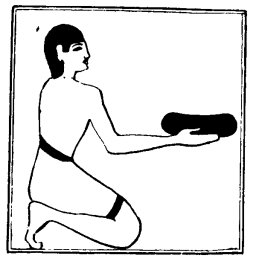
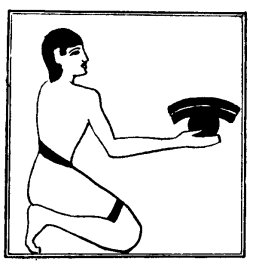
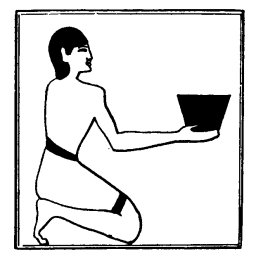
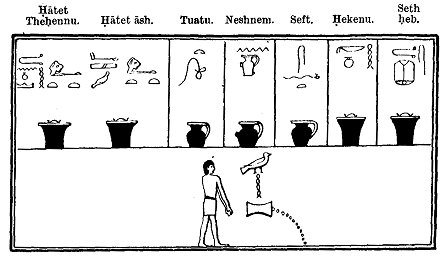
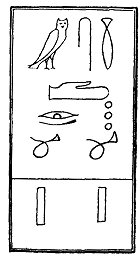
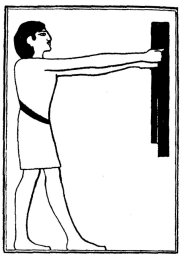
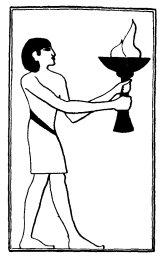
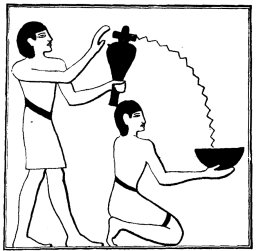


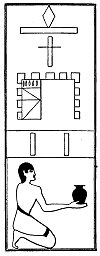
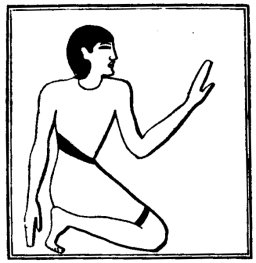

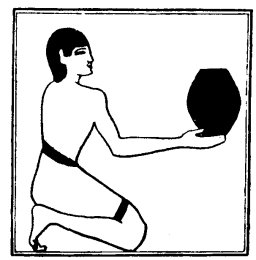
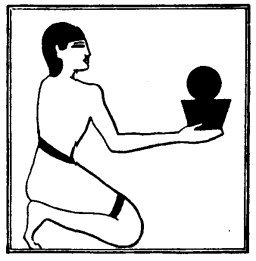
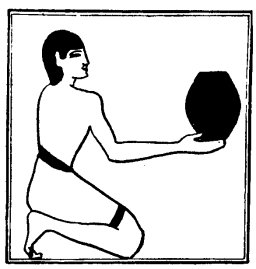
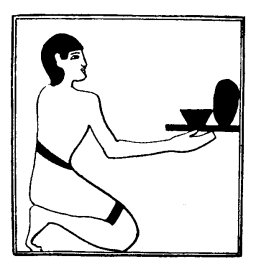
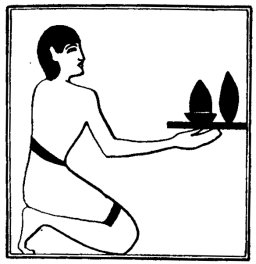



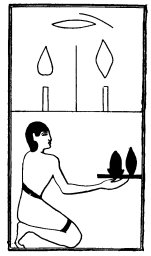
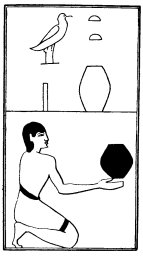
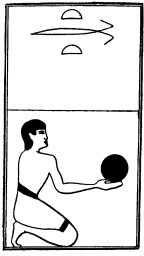
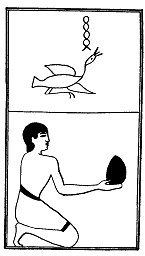
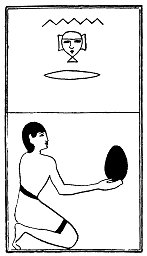

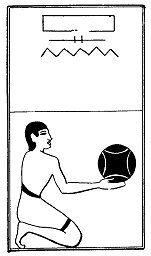
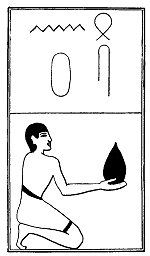
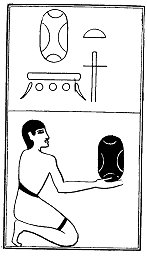


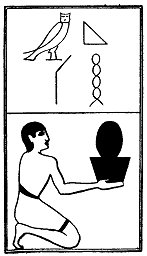
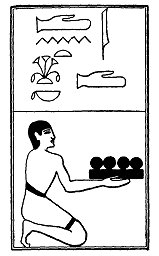
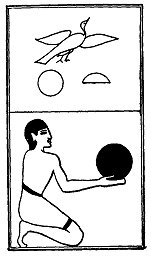
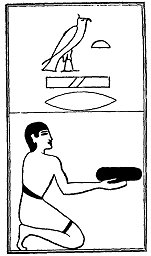
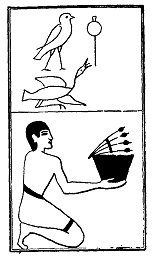





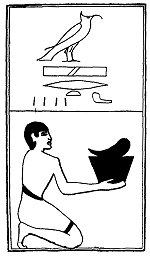

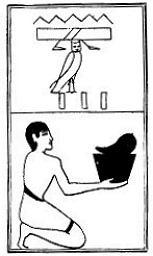
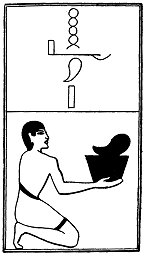









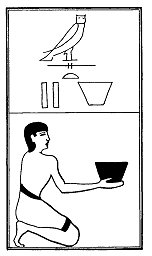






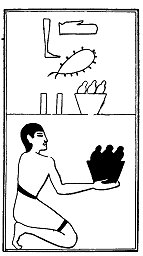














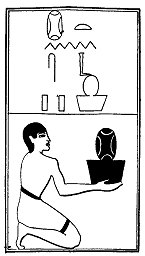





0 comments:
Post a Comment
Note: Only a member of this blog may post a comment.